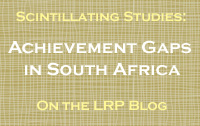

by Mastin Prinsloo and Carolyn McKinney
University of Cape Town
October 14, 2013
Blommaert, J. (2010). The Sociolinguistics of Globalization. Cambridge: CUP.
Blommaert, J. (2008). Grassroots Literacy: Writing, Identity and Voice in Central Africa. London: Routledge.
Blommaert, J., Muyllaert, N., Huysmans, M. & Dyers, C. (2005). Peripheral normativity: Literacy and the production of locality in a South African township school, Linguistics and Education, 16(4), 378-403.
Canagarajah, A. S. (2013). Negotiating mobile codes and literacies at the contact zone: Another perspective on South African township schools. In Language, Literacy and Diversity: Moving Words, C. Stroud and M. Prinsloo (eds). London: Falmer.
 An alarming aspect of South African schooling is the huge gap between the small number of schools where students from middle-class homes are doing well, going on to university study, on the one hand, and the large majority of schools, on the other, where pass rates and school completions rates are very low indeed. Comparative analyses of national test results in reading and maths for Grades 1 to 6 show around 20% of students excelling and 80% doing very badly, as if there were two separate schooling systems operating within the public schooling system, one for the children of the elite and the other for the large majority of students. This situation is of great concern, particularly in a country that is dealing with the legacies of racialised inequalities as well as various kinds of skills shortages.
An alarming aspect of South African schooling is the huge gap between the small number of schools where students from middle-class homes are doing well, going on to university study, on the one hand, and the large majority of schools, on the other, where pass rates and school completions rates are very low indeed. Comparative analyses of national test results in reading and maths for Grades 1 to 6 show around 20% of students excelling and 80% doing very badly, as if there were two separate schooling systems operating within the public schooling system, one for the children of the elite and the other for the large majority of students. This situation is of great concern, particularly in a country that is dealing with the legacies of racialised inequalities as well as various kinds of skills shortages.
A number of studies have addressed questions about racial and socioeconomic achievement gaps in South African schools, and we focus here on the beginnings of a debate that starts with an analysis by Jan Blommaert, prominent sociolinguist. Blommaert brings the interesting idea of ‘scale’ to the study of literacy across diverse settings. He suggests that language and literacy practices are subject to social processes of hierarchical ordering. Societies marked by deep inequality, he says, characteristically produce different layers and niches in which very different ways of life are developed on the basis of rules, norms and opportunities not valid elsewhere. One consequence thereof is that one can be a ‘‘good’’ user of language or literacy in the neighbourhood network, but a ‘‘bad’’ one in the schooling system and the labour market.
Blommaert identifies what he calls "grassroots literacy" as a characteristic form of writing across poor communities in Africa. He describes it as a non-elite form characterised by the use of graphic symbols in ways that defy orthographic norms: words spelled in different ways, often reflecting the way they are pronounced in spoken vernacular varieties rather than following conventional orthographic norms or prestige language forms. He finds an uncertainty about linguistic and stylistic rules, as well as a common use of drawing as well as writing. Such texts, he says, have localvalue, but examined from beyond the local, they appear as inferior examples of writing, pointing to the low status of these persons on a larger stage. In a study carried out with students and colleagues from the University of the Western Cape at a Cape Town township school, he identified students’ writing as featuring grammatical, spelling and other deviations that characterise ‘grassroots literacy’ and found the same features in teachers’ writing, evidence of new, but low status, norms that are being developed.
Suresh Canagarajah has since carried out a study of his own in a similarly poorly resourced Western Cape township school setting to that of Blommaert and colleagues and he has disagreed with aspects of Blommaert’s analysis. He disagrees with Blommaert’s treatment of literacy regimes as somewhat autonomous and separate, with their own logic, cut off from others. He argues that while particular communities might display characteristic writing forms, they are not necessarily ‘stuck’ or ‘locked’ into using only these forms in the way Blommaert suggests.
Canagarajah’s own study finds in the texts of the students a recognition of different norms carrying more or less status in different social contexts. In their writings on a school Facebook site, students’ use of non-standard spelling and orthography is evident in their mixing of English and isiXhosa, abbreviations and icons. He identifies their writing here as a hybrid form of literacy activity, combining oral and literate resources and diverse languages. In their classroom written work, however, students don’t mix codes in the same way and Canagarajah suggests they have shifted to a translocal norm, approximating to Standard Written English and with an emerging sense of the genre requirements of school essay writing. While student writing displays the types of grammatical problems that Blommaert identified, Canagarajah sees teachers as selectively correcting these as they move students to the developing of their translocal English-language writing resources, from a constrained starting point. He argues that it might be more productive to see social spaces as contact zones than as separated ones, with diverse language and literacy resources in the same social space. Much depends, he says, on how people negotiate these mobile resources.
The issue of the unequal status of different kinds of language and literacy resources and of what to do about students’ ‘non-standard’ language resources is a thorny one in education. The debate reviewed here suggests that it is important for us as teachers not only to be aware of diverse language and literacy resources but to develop students’ sociolinguistic awareness so that they have the opportunity to interrogate why different resources carry different status as well as to use the full range of their resources.
Reader response is welcomed. Email your comments to LRP@/
The views expressed in this piece are the author's (or authors') and should not be taken as representing the position of the International Literacy Association or of the ILA Literacy Research Panel.